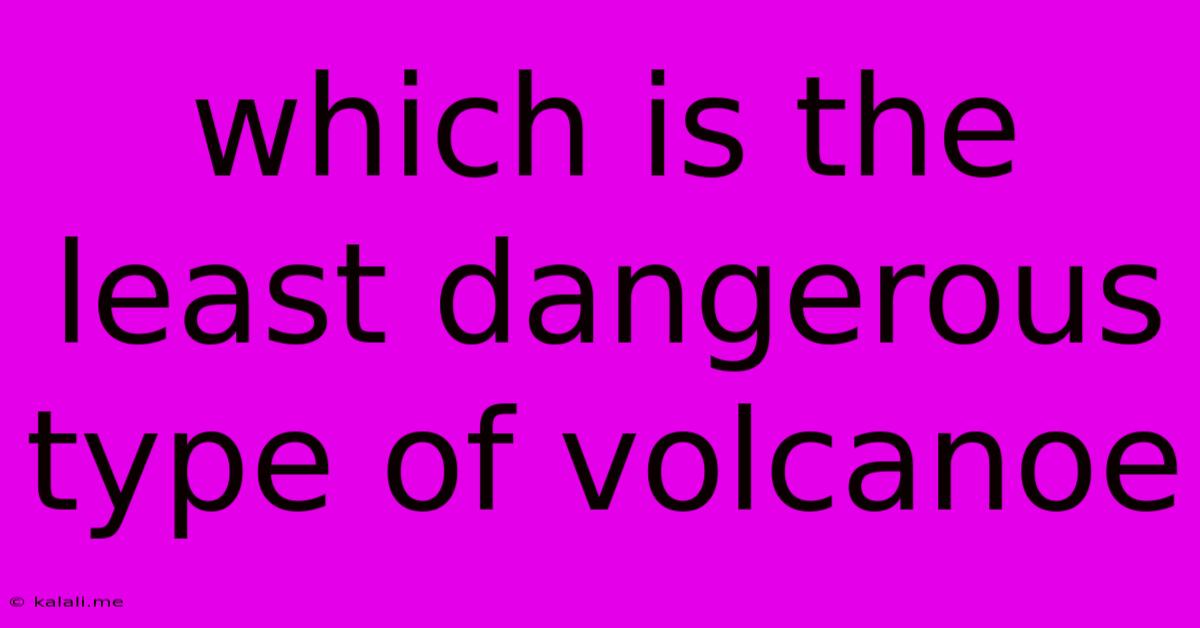Which Is The Least Dangerous Type Of Volcanoe
Kalali
May 09, 2025 · 3 min read

Table of Contents
Which is the Least Dangerous Type of Volcano? Understanding Volcanic Hazards
Volcanoes, while awe-inspiring in their power, represent a significant geological hazard. However, not all volcanoes are created equal. The level of danger associated with a volcano depends heavily on its type, eruptive style, and geographical location. This article explores the different types of volcanoes and identifies which generally poses the least threat to human life and property. Understanding this allows for better risk assessment and mitigation strategies.
Understanding Volcanic Types and Their Eruptive Styles
Before we can determine the least dangerous type, it's crucial to understand the main classifications:
-
Shield Volcanoes: These are characterized by their broad, gently sloping sides, formed by the accumulation of highly fluid basaltic lava flows. Their eruptions are typically effusive, meaning the lava flows relatively slowly, giving ample time for evacuation. While they can produce large lava flows that cover extensive areas, they rarely generate explosive eruptions.
-
Cinder Cones: These are smaller, steeper volcanoes built from the accumulation of pyroclastic material (fragments of solidified lava, volcanic ash, and pumice) ejected during explosive eruptions. Their eruptions are usually short-lived and relatively less voluminous compared to other volcano types. However, they can still be dangerous due to the potential for ballistic projectiles and pyroclastic flows (fast-moving currents of hot gas and volcanic matter).
-
Composite Volcanoes (Stratovolcanoes): These are the most dangerous type of volcano. They are characterized by their steep slopes, formed by alternating layers of lava flows and pyroclastic deposits. Their eruptions are typically explosive, producing significant ash clouds, pyroclastic flows, lahars (volcanic mudflows), and volcanic bombs. The potential for widespread devastation is high due to the intensity and variety of hazards they pose.
-
Lava Domes: These are formed by viscous lava that piles up near the volcanic vent. They are often found within the craters of composite volcanoes. Their eruptions are typically slow, with the lava being too thick to flow far. However, pressure buildup can lead to explosive eruptions of the dome itself, resulting in dangerous pyroclastic flows.
-
Subglacial Volcanoes: These volcanoes erupt beneath glaciers or ice sheets. Their eruptions can melt vast amounts of ice, creating catastrophic jökulhlaups (glacial outburst floods). The interaction of magma and ice also produces highly explosive eruptions.
The Least Dangerous: A Qualified Answer
Based on the eruptive styles and associated hazards, shield volcanoes generally pose the least danger. Their effusive eruptions, characterized by slow-moving lava flows, provide more time for warning and evacuation. The relatively low explosivity minimizes the risk of pyroclastic flows, ash clouds, and ballistic projectiles.
However, it's important to note this is a relative statement. Even shield volcanoes can cause significant damage to property due to the sheer volume of lava produced. Lava flows can engulf towns and villages, destroy infrastructure, and disrupt daily life. Therefore, while the immediate threat to life may be less compared to other volcanic types, the economic and social impacts can still be substantial. Furthermore, the location of a shield volcano significantly impacts its danger level; one near a densely populated area is far more dangerous than one in a remote location.
Conclusion: Risk Assessment is Key
While shield volcanoes represent the least hazardous type overall, the level of danger associated with any volcano depends on a complex interplay of factors. Thorough monitoring, accurate risk assessment, and effective emergency response plans are crucial to minimize the potential impact of volcanic eruptions, regardless of the type of volcano. The unpredictable nature of volcanoes necessitates a cautious and proactive approach to volcanic hazard management.
Latest Posts
Latest Posts
-
How Long Is 60cm In Feet
May 10, 2025
-
What Is 1 92 M In Feet
May 10, 2025
-
Cuanto Es 28 Fahrenheit En Centigrados
May 10, 2025
-
How Many Feet Are In 59 In
May 10, 2025
-
Lowest Common Multiple Of 12 And 30
May 10, 2025
Related Post
Thank you for visiting our website which covers about Which Is The Least Dangerous Type Of Volcanoe . We hope the information provided has been useful to you. Feel free to contact us if you have any questions or need further assistance. See you next time and don't miss to bookmark.